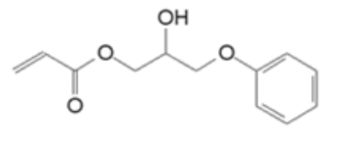Enhanced TDS
Identification & Functionality
- CASE Ingredients Functions
- Chemical Family
- Function
- Reactive Diluent
- Product Code
- MITM16319
- Technologies
- Product Families
- Chemical Structure

Features & Benefits
- CASE Ingredients Features
- Performance Highlights
EBECRYL® 118 is characterized by:
- Low viscosity
- Secondary hydroxyl functionality
UV/EB cured products containing EBECRYL® 118 are characterized by the following performance properties:
- Good reactivity
- Improved flexibility
- Decreased Tg
- Reduced shrinkage, improved adhesion
- Moisture resistance
The actual properties of UV/EB cured products also depend on the selection of other formulation components such as reactive diluents, additives and photo initiators.
Applications & Uses
- Application Method
- Coating End Applications
- Compatible Polymers & Resins
- Compatible Substrates & Surfaces
- Cure Method
- Ink & Toner End Applications
- Product Applications
Formulated UV/EB curable products containing EBECRYL® 118 may be applied via direct or reverse roll, offset gravure, metering rod, slot die, knife over roll, air knife, curtain, immersion, and spin coating methods, as well as offset and screen printing.
EBECRYL® 118 is recommended for use in:
- Coatings and inks with adhesion to plastics such as treated polyolefins and plasticized PVC
- Flexible coatings for paper and plastic
- 3D printing/additive manufacturing formulations
- Moisture resistant coatings
Properties
- Physical Form
Principal Information
- Group Principal Number
- S000001
- Principal
Storage & Handling
- Storage Conditions
- Care should be taken not to expose the product to high temperature conditions, direct sunlight, ignition sources, oxidizing agents, alkalis or acids.
- This might cause uncontrollable polymerization of the product with the generation of heat.
- Storage and handling should be in stainless steel, amber glass, amber polyethylene or baked phenolic lined containers.
- Procedures that remove or displace oxygen from the material should be avoided.
- Do not store this material under an oxygen free atmosphere.
- Dry air is recommended to displace material removed from the container.
- Wash thoroughly after handling. Keep container tightly closed. Use with adequate ventilation.
Other
- Appearance
- Clear liquid
- Appearance (SDS)
- Clear, non-viscous liquid
- Color (SDS)
- Light yellow
- IATA/ICAO Proper Shipping Name
- Environmentally hazardous substance, liquid, N.O.S.
- IATA/ICAO Technical name (N.O.S.)
- Acrylic oligomer
- IATA/ICAO UN Number
- UN3082
- IMO/IMDG Proper Shipping Name
- Environmentally hazardous substance, liquid, N.O.S.
- IMO/IMDG Technical name (N.O.S.)
- Acrylic oligomer
- IMO/IMDG UN Number
- UN3082
- Odor (SDS)
- Acrylate
- Other Hazards
- Polymerization may occur from excessive heat, contamination or exposure to direct sunlight .
- Protect from Freezing
- Yes
- TDG Canada Proper Shipping Name
- Environmentally hazardous substance, liquid, N.O.S.
- TDG Canada Technical name (N.O.S.)
- Acrylic oligomer
- TDG Canada UN Number
- UN3082
- Temperature Control
- Yes
- USA/DOT Proper Shipping Name
- Environmentally hazardous substance, liquid, N.O.S.
- USA/DOT Technical name (N.O.S.)
- Acrylic oligomer
- USA/DOT UN Number
- UN3082
- Chemical Properties
Value Units Test Method / Conditions Acid Value max. 2.0 mg KOH/g mg KOH/g - Mechanical Properties
Value Units Test Method / Conditions Elongation 265.0 % % at Break Tensile Modulus 11600.0 psi psi Dynamic Mechanical Analysis (DMA) Tensile Strength 1300.0 psi psi - Optical Properties
Value Units Test Method / Conditions Color Scale max. 2.0 Gardner Gardner Gardner Color Scale Refractive Index 1.528 - at 20°C - Physical Properties
Value Units Test Method / Conditions Density 1.16 g/mL g/mL At 25°C Glass Transition Temperature (Tg) max. 25.0 °C °C Dynamic Mechanical Analysis (DMA) UV cured 125 μm thick films, tan (Delta) Molecular Weight 222.0 g/mol g/mol Storage Temperature 39.0-104.0 °F °F Viscosity 215.0 mPa.s mPa.s At 25°C - SDS Physical and Chemical Properties
Value Units Test Method / Conditions Autoignition Temperature (SDS) 443.0 °C °C Boiling Point (SDS) min. 200.0 °C °C Density (SDS) 1.12-1.17 g/cm³ g/cm³ at 20°C Flash Point (SDS) 212.0 °C °C at 1.013 hPa Melting Point (SDS) -48.0 °C °C Solubility In Water (SDS) 5.3 g/L g/L at 20°C Vapor Pressure (SDS) 0.004 hPa hPa At 25°C Viscosity (SDS) 150.0-300.0 mPa.s mPa.s at 25⁰C, low viscous liquid Volatile Content (SDS) max. 0.1 %(W/W) %(W/W) - Shelf Life & Stability
Value Units Test Method / Conditions Shelf Life 0.0 d d
